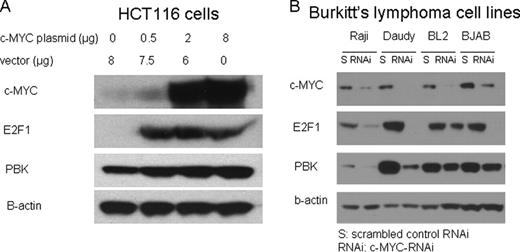Abstract
Abstract 1569
PBK (PDZ-binding kinase) is a serine-threonine kinase that was originally cloned as an interaction partner with the human tumor suppressor hdlg, as an IL-2 inducible gene in cytotoxic T lymphocytes and as an expressed sequence tag in Burkitt's lymphoma (BL) cells. PBK/TOPK mRNA is expressed in normal testicular and embryonic tissues, proliferating neural progenitor cells, various tumor cell lines and in aggressive hematopoietic neoplasms. Previously E2F1 and CREB/ATF were identified as transcriptional regulators of PBK (Leuk Res, 2006). Recently, we reported that PBK interacts with tumor suppressor p53 via its DNA binding domain and modulates its function as a transcription factor (Oncogene, 2010). These lines of evidence point to PBK as a novel oncoprotein with possible relevance as a therapeutic target. c-MYC is the hall mark for Burkitt's lymphoma, and it is highly expressed in various other hematological malignancies. E2F1 is one of the transcriptional targets of c-MYC. The association of PBK expression with aggressive hematologic neoplasms and BL in particular, suggested a possible role of a c-MYC-E2F1-PBK axis in the pathogenesis of hematological malignancies.
To investigate the frequency of PBK expression in a larger number of hematopoietic neoplasms and determine whether c-MYC has a role in PBK expression.
Immunohistochemistry for PBK, E2F1 and c-MYC expression on malignant lymphoma tissue microarrays (US Biomax) was conducted. The slides were scored by a blinded hematopathologist (XFZ) according to the following criteria: For staining (0–10), 0= no tumor cells were stained; 1 = 10% tumor cells were stained; 10= 100% tumor cells were stained. For intensity (0–4), 0= no staining; 1= weak; 2=intermediate; 3=strong; 4=very strong. Spearman rank correlation coefficient analysis was used to measure relationships in expression among c-MYC, E2F1 and PBK. To confirm the results from immunohistochemistry assay, effects of c-MYC on expression of E2F1 and PBK were investigated by knocking down c-MYC in Burkitt's lymphoma cell lines and overexpressing c-MYC in HCT116 cells, followed by Western blot analysis for E2F1 and PBK levels.
PBK was expressed in 100% of BL samples (N=8), 80% of Diffuse large B-cell Lymphoma (DLBCL) (N=10), 40% of myeloma samples (N=10), 50% of Hodgkins (HL) samples (N=10) but 0/3 Follicular lymphoma (FL) samples, 1/3 T-cell lymphoma samples and 0/4 normal lymph nodes. Among all 44 cases of malignant lymphoma, staining of PBK, E2F1 and c-MYC were significantly positively correlated: Spearman rank correlation coefficient (ρ) between c-MYC and E2F1 is 0.455 (p=0.0028), ρ=0.874 for E2F1 and PBK(p<0.0001), and ρ=0.537 for c-MYC and PBK(p=0.0004); Staining intensity of these three proteins were also significantly positively correlated: ρ=0.407 for c-MYC and E2F1 (p=0.0077), ρ=0.849 for E2F1 and PBK(p<0.0001),and ρ=0.479 for c-MYC and PBK (p=0.0017). In 10 cases of (DLBCL), staining of PBK, E2F1 and c-MYC were significantly positively correlated: Spearman rank correlation coefficients are 0.721, 0.929, and 0.797 for c-MYC and E2F1(p=0.0319), E2F1 and PBK(p<0.0057), c-MYC and PBK(p=0.0177), respectively; In terms of staining intensity of these proteins, Spearman rank correlation coefficients are 0.849, 0.963, and 0.908 for c-MYC and E2F1(p=0.0114), E2F1 and PBK(p=0.0041), c-MYC and PBK(p=0.0068), respectively, in 8 cases of Burkitt's lymphoma, staining intensity of PBK was found to be correlated to that of c-MYC (ρ=0.755, p=0.0492). Gene knockdown experiments in BL2, BJAB, Raji, Daudi cells showed that inhibition of c-MYC expression could downregulate both E2F1 and PBK, whereas overexpression of c-MYC in HCT116 cells increased expression of E2F1 and PBK.
PBK protein was highly expressed in a high proportion of Burkitt lymphoma and diffuse large B-cell lymphoma and in a lesser % of Hodgkin lymphoma and myeloma cases, suggesting that PBK is expressed in a relatively high proportion of aggressive hematologic neoplasms. Expression of PBK was correspondent to and subjected to regulation by c-MYC and E2F1 in these lymphomas. These new results in combination with our earlier data as well as the adverse prognostic implications of c-MYC expression in malignant lymphomas suggest that PBK function may be a rational target for novel anti-neoplastic therapeutics.
No relevant conflicts of interest to declare.
Author notes
Asterisk with author names denotes non-ASH members.


This feature is available to Subscribers Only
Sign In or Create an Account Close Modal